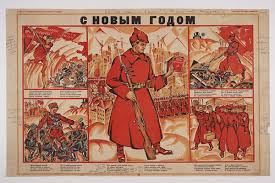The Bolsheviks’ new army, which they called the Workers’ and Peasants’ Red Army (Raboche Krest’ianskaia Krasnaia Armiia, RKKA) did, surprisingly enough, start out nearly as Lenin had envisioned. Based on Red Guard detachments the Bolsheviks’ first military force was completely voluntary, drawn from the working class, and determined to defend the revolution. It soon became apparent to even the most idealistic of revolutionaries, however, that groupings of Red Guards did not constitute an army. The civilian leadership also quickly realized that the tasks at hand, such as preserving an empire threatened by independence movements and defending their fledgling Bolshevik government from a counterrevolutionary civil war and foreign intervention, required a real army and all it entailed. In March 1918 Lenin assigned Leon Trotsky the task of creating a true army.
Trotsky wisely dropped most of his Marxist utopian preconceptions of what an army ought to look like and immediately began forming an army along traditional lines. This included creation of a hierarchy of officers and enlisted men and provisions for military discipline and organization. Initially recruitment was limited to the working class, but this soon proved to be inadequate and the gates were flung open to all comers except rich peasants, the clergy, bourgeoisie and, with exceptions, the nobility. Manning the army on a voluntary basis also went by the wayside rather quickly; the regime instituted conscription early in 1918. The most controversial aspect of Trotsky’s new army was his reliance on former tsarist officers to train and even lead units of the Red Army. Such dependence on the avowed class enemy was anathema to the average Bolshevik and caused considerable turmoil in the party. This army, which swelled to nearly five million men at its peak, successfully fought a civil war preserving Bolshevik dominance, though it failed to restore Russia’s pre-1914 borders.
Demobilization of the Red Army began in late 1920 and the debate resumed on the form the peacetime armed force would take. Once again Marxist idealists resurrected the idea of a citizens’ army but were now challenged by those Bolsheviks desiring a professional standing army. A compromise resulted. In 1921, the party accepted the need for a standing army but insisted that the bulk of the country’s military force would be its reserve, the citizen army. The compromise was viewed differently by the two opposing camps: the socialist idealists accepted the standing army as a temporary but necessary evil, expecting that once the conditions for true socialism were achieved the standing army would be done away with. Those in favor of a large and permanent standing army accepted the small active army and large territorial militia as a temporary expedient that would eventually result in a large standing army and small reserve once the economy became strong enough to support it.
The Communist Party still insisted that the standing army reflect the revolutionary ideals that guided the party’s transformation of civilian society. It would not be a replica of the old tsarist army. The political and military leadership, despite their abandonment of a fundamental tenet of socialist philosophy, honestly attempted to create an army of a new type in officer-enlisted relations, discipline, war-making doctrine, and quality of life in contrast to the Imperial Russian Army. The regime believed their army could be a tool of social transformation for the masses. Some military theorists even believed that socialism would be the basis of a new method of warfare. Ultimately the idealism waned, and by 1941 the Red Army in many ways, both intentionally and unintentionally, resembled the reviled and much maligned imperial army. Between 1945 and 1991 the Red Army completely fell away in practice from its founding revolutionary vision and resembled the tsarist army of the nineteenth century more than it did the Soviet Army of the 1920s. The process of this transition and the attendant ramifications are major themes of this book.
The early history of the Red Army is the story of the Soviet regime’s attempts to create an army that not only treated its soldiers well, but also tried to elevate their consciousness. It is the story of perhaps the world’s first political army in the sense that the military leadership of the Red Army shared decision-making responsibility with a political party. The Communist Party’s values became so intertwined with those of the military that the two became virtually indistinguishable. This union of party and army seemed logical and necessary to the party and was never seriously challenged by the army, yet proved to be the source of some of the weakness of the armed forces.
The Second World War shows the Red Army at both its nadir and pinnacle of effectiveness. The war began with the catastrophe of German invasion and ended with the Soviet conquest of Eastern Europe. In between, the army reverted to many Civil War practices that proved costly in lives but also developed new methods of manning that promoted cohesion and morale. The leadership of the army matured under fire ultimately rising to the occasion. Soviet society temporarily became wedded to the army in the way Lenin envisioned in 1917, and the army temporarily became a trusted and respected institution by most.
